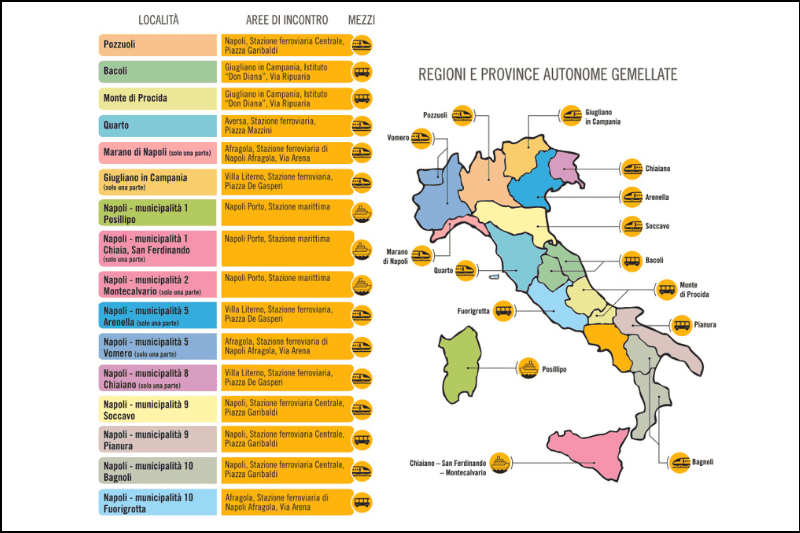What to know - Volcanic risk

The Phlegraean Fields is a vast active volcanic area with a structure called a "caldera," that is, a lowered area with an almost circular shape that was formed by large explosive eruptions. The caldera of the Phlegraean Fields extends from Monte di Procida to Posillipo and also includes an underwater part in the Gulf of Pozzuoli. Within the caldera, more than 70 eruptions have occurred over the past 15,000 years, forming volcanic buildings, craters and volcanic lakes that are still visible, such as Astroni, Solfatara and Lake Averno. The last eruption, in 1538, was preceded by a ground uplift that reached 19 meters in two years and gave rise to the volcano Monte Nuovo. Since then, the caldera has been quiescent, "dormant," but now shows signs of activity such as seismicity, fumaroles, and ground deformation.
The caldera of the Phlegraean Fields is featured by the phenomenon of bradyseism, which shows slow lowering (subsidence) and more rapid uplift phases. The most recent major bradyseism crises occurred between 1969-1972 and 1982-1984, resulting in a total ground uplift of more than three meters and hundreds of earthquakes. During these crises, Pozzuoli's historic center residents were evacuated and relocated to neighborhoods on the city's outskirts.
Since 2006, a new phase of ground uplift has been ongoing. In 16 years, the ground has risen by about one meter and caused many earthquakes.
Since 2012, the prolonged variations in some geophysical and geochemical parameters recorded by the monitoring networks of the INGV—Vesuvius Observatory (increased seismicity, changes in the geochemical composition of fumaroles and gases from the ground, and, of course, soil uplift) have required raising the warning to yellow level and activating the operational phase of "attention."
In the past, the volcanic activity of the Phlegraean Fields has been mainly characterized by explosive eruptions. This type of eruption, and the following phenomena, could also be expected in the future:
- formation of an eruptive column of gases and shreds of incandescent lava, high up to tens of kilometres;
- falling of large volcanic material in the area closest to the eruptive mouth, and also of ash and lapilli up to ten kilometers away, along the wind direction;
- pyroclastic flows (avalanches of gas, ash and volcanic fragments) generated by the collapse of the eruptive column. These flows have high speeds and temperatures and can flow for several kilometres;
- phreatic explosions, particular explosive phenomena that occur mainly in areas with intense hydrothermal activity, such as that of Solfatara/Pisciarelli;
- flooding of depressed areas, due to abundant rainfall generated by the water steam released during the eruption and the accumulation of volcanic ash that makes the soil impermeable.
Phlegraean Fields are among the most monitored volcanoes in the world because eruptions are often preceded by “precursor” phenomena (earthquakes, soil deformations, changes in composition and temperature of fumaroles, etc.).
The monitoring of these phenomena is fundamental to determine the state of activity of the volcano, the alert level, and also for the implementation of the measures provided for in the Civil Protection Plan. However, the present scientific knowledge does not allow to predict with certainty when, how and where the next eruption will occur, also because of the peculiarities of the caldera. Also, it is not possible to predict the duration of the eruption.
The alert system provides specific “alert levels” describing the state of activity of the volcano, based on the parameters of monitoring and any ongoing phenomena. The green alert level corresponds to the ordinary activity of the volcano while the yellow, orange and red alert levels represent increasing stages of unbalance of the volcano towards a possible eruption. The duration of each alert level can be extremely variable.
The alert levels are declared by the Department of Civil Protection, in conjunction with the regional civil protection. A possible change in level is assessed on the basis of the indications provided by the Vesuvian Observatory of the National Institute of Geophysics and Volcanology and the opinion of the National Commission for the Forecasting and Prevention of Major Risks. Actions to be implemented by the National Civil Protection Service are defined in the operational phases (attention phase, pre-alarm and alarm) provided for in the civil protection plans. The President of the Council of Ministers declares the pre-alarm and the alarm phase.
For the red zone, the only preventive measure is to remove the population before the eruption begins. People can decide whether to find accommodation outside the risk zones or to benefit from accommodation offered by the State in the Autonomous Region or Province twinned with their Municipality.
For the yellow zone, the removal of the population will be assessed on the basis of the current event, the direction of the winds and the extent of the eruption. The Plan for volcanic risk at the Phlegraean Fields is set at national level, therefore it must be drawn up by the entire National Service of Civil Protection starting from the Civil Protection Department, the Campania Region, the Prefecture of Naples, the Municipalities of the red zone, the Regions and twinned autonomous Provinces.
The red zone encompasses the area exposed to pyroclastic flows which, due to their high temperatures and speed, represent the most dangerous phenomenon for people.
The red zone includes the municipalities of Pozzuoli, Bacoli, Monte di Procida and Quarto; part of the municipalities of Giugliano in Campania and Marano in Naples; some districts of Naples: Soccavo, Pianura, Bagnoli, Fuorigrotta and part of the districts of San Ferdinando, Posillipo, Chiaia, Arenella, Vomero, Chiaiano and Montecalvario.
The yellow area includes the area exposed to the danger of lapilli and volcanic ash fallout.
The yellow zone includes the municipalities of Villaricca, Calvizzano, Marano di Napoli, Mugnano di Napoli, Melito di Napoli, Casavatore and 24 districts of the Municipality of Naples: Arenella, Avvocata, Barra, Chiaia, Chiaiano, Mercato, Miano, Montecalvario, Pendino, Piscinola, Poggioreale, Porto, San Carlo all’Arena, San Ferdinando, San Giovanni a Teduccio, San Giuseppe, San Lorenzo, San Pietro a Patierno, Scampia, Secondigliano, Stella, Vicaria, Vomero and Zona Industriale.

In the pre-alarm phase, people wishing to leave the red zone can do it independently, moving to an alternative accommodation (second home, to relatives or friends, rented house) and receiving a financial contribution from the State.
In the alarm phase, the population can decide whether to move by their means, notifying their municipality, following the routes provided by the plan and according to the timetable established, or by means made available by the State. It is possible to decide whether to move to an alternative accommodation chosen independently and receive a financial contribution from the State or benefit from the accommodation offered in the twinned Region or Autonomous Province. Those who decide to leave with the means made available by the State must go to the waiting area identified by the Municipal Civil Protection Plan, either independently or with the shuttles organized by their municipality. From here, the transfer to the meeting area outside the red zone will take place with the buses of the Campania Region, while the transfer to the twinned Region or Autonomous Province will be provided by the means of transport identified by the planning (train, bus, ship). Details regarding the transfer and reception of the population will be defined in the Plans of the individual Regions and Autonomous Provinces.
The IT-alert public warning system for the risk of eruption in the is used to give early warning of a potential upcoming eruption in the Phlegraean Fields with the resulting need to take civil protection actions, including the evacuation of the population living in the red zone, provided for in the plans. When the operational phase of "alarm" is activated, an IT-alert message is sent to the cell phones of those in the Campania region to inform them of the potential danger. It is, therefore, essential to know what to do right away.
- If you live, work or stay in the Phlegrean Fields territory, check if your area is in the red or yellow zone.
- Eruptions can be preceded by earthquakes: keep in mind the rules of conduct that you can find on this website at the page I don't take risks - Earthquake
- Volcanic gases released by the caldera, in certain concentrations, can be very dangerous to human health and animals. Some of these gases are odorless, tasteless and colorless and therefore cannot be perceived.
- The only safeguard for the population living in the red zone is the evacuation before the beginning of the eruption. Buildings would not offer safe shelter.
- The evacuation operation lasts three days (72 hours) from the start of the operational phase of "alarm".
- The activation of the operational alarm phase won't be necessarily followed by a volcanic eruption. However, access to the area remains forbidden until the civil protection authorities provide different indications.
- In the event of an eruption, the yellow area is exposed to lapilli and volcanic ash fallout. The evacuation of the population from this area will be assessed on the basis of the event in progress, wind direction and the magnitude of the eruption. Over-accumulation of ash could cause the collapse of the roofs.
- It will not be possible to immediately determine when people can return to their houses after evacuating during the "alarm phase." Keep up to date with the information provided by the civil protection authorities.
- Italy has equipped itself with a public warning system, IT-alert, for direct information to the population, which broadcasts messages to cell phones in a given geographical area in case of imminent or ongoing major emergencies or disasters, including an upcoming eruption in the Phlegrean Fields. Remember that the IT-alert system has some limitations. For more information, go to www.it-alert.gov.it/en.